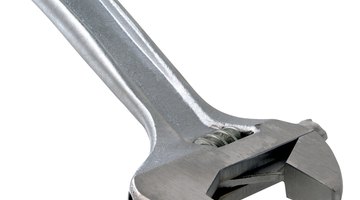How to Use an Encased Sewer Rod
Blockages in sewer lines can be created through excessive use of toilet tissue, grease sticking to the inner walls of the pipe, a buildup of hair and other debris or even tree roots entering the line through coupling joints.

Things You Will Need
- Adjustable wrench
- White sealing tape
Where a regular sewer snake is rotated when in the sewer pipe, an encased sewer rod is pushed backwards and forwards through the blocked area. The rod is encased in plastic or metal, with some models having a wind up/wind out handle.
-
Place an adjustable wrench around the central nut of the cap on the sewer pipeline's Y access fitting. Turn the wrench handle counterclockwise to loosen and remove the cap.
-
Pull about four feet of rod from its casing. If the casing has a handle, wind out the rod from its casing. Insert the rod into the sewer pipeline through the access fitting. Continue to feed the rod into the line until the end of the rod meets resistance by meeting the blockage.
-
Pull the rod back a little, then push it forward again to meet the blockage -- do this manually, or with the handle. Repeat this several times until the end of the rod pushes through the blockage, breaking it up.
-
Pull the rod out of the sewer line, cleaning it with a rag before feeding it back into the casing.
-
Wrap white sealing tape clockwise around the threads on the access fitting's end cap. Screw the cap by hand into the end of the access fitting. Tighten the cap in place with the wrench.
-
Pour water down into the sewer line. Flush a toilet or run a faucet to swill away all remnants of the blockage.
Tip
Encased sewer rods can also be inserted into the sewer line through toilet bowls or sinks. The P-trap bend must be removed first from under the sink, and the rod inserted into the end of the sewer pipe coming out of the wall. Encased sewer rods are generally longer than regular sewer snakes, being 40 or 50 feet long.
References
- "Home Improvement 1-2-3"; Christopher Cavanaugh; 1995
- Lowes: Cobra Encased Sewer Rod
Tips
- Encased sewer rods can also be inserted into the sewer line through toilet bowls or sinks. The P-trap bend must be removed first from under the sink, and the rod inserted into the end of the sewer pipe coming out of the wall.
- Encased sewer rods are generally longer than regular sewer snakes, being 40 or 50 feet long.
Writer Bio
Steve Sloane started working as a freelance writer in 2007. He has written articles for various websites, using more than a decade of DIY experience to cover mostly construction-related topics. He also writes movie reviews for Inland SoCal. Sloane holds a Bachelor of Arts in creative writing and film theory from the University of California, Riverside.
Photo Credits
- Brand X Pictures/Brand X Pictures/Getty Images
- Brand X Pictures/Brand X Pictures/Getty Images
More Articles



